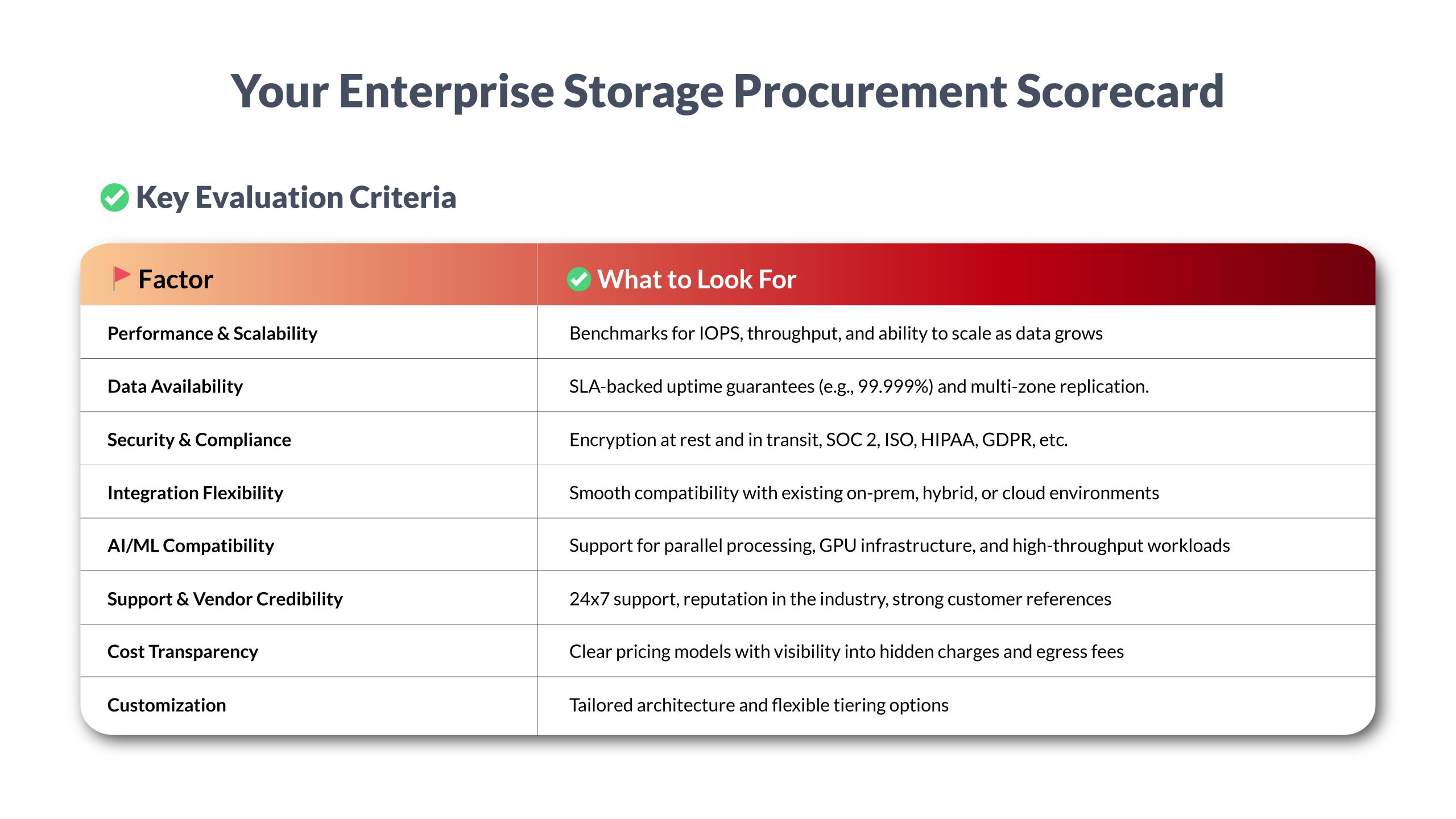Storage decisions shape how fast your business can grow, respond, and innovate. Whether you’re building AI/ML capabilities, running data-heavy analytics, or scaling digital operations, the demand for smart, high-performance storage has never been higher.
But not all providers are built the same. Poor storage choices can lead to performance bottlenecks, hidden costs, and long-term security risks.
Global data is expected to reach 200 zettabytes by 2025. Hence, Data stored in the cloud is projected to reach 100 zettabytes in 2025 as well. (SOURCE: Edge Delta)
That’s why enterprise storage vendor selection isn’t just a procurement task; it’s a strategic move. The right partner brings scalability, reliability, and future-proof architecture to the table.
How to Define Your Storage Needs Based on Use Cases, Performance Goals, and Infrastructure Strategy
Before comparing vendors or solutions, it’s critical to map your business requirements to storage capabilities. The right fit depends not just on capacity, but on how your data will be used, managed, and scaled over time.
- Clarify the Use Cases
Are you storing backups, running AI/ML workloads, enabling real-time analytics, or meeting strict compliance mandates? Each function demands different storage characteristics, speed, latency, durability, and retrieval efficiency.
- Evaluate Capacity, Performance & Scalability Trade-offs
Not all storage is created equal. For big data storage solutions, the system must handle massive volumes without performance bottlenecks. For AI/ML, a low-latency, high-throughput architecture is essential. Think about how quickly your data will grow and how responsive your system must be.
- Align with the Right Infrastructure Setup
Should you go all-in on cloud, stick with on-prem, or adopt a hybrid model? Each option affects cost, control, and flexibility. Your decision should match your IT maturity, compliance posture, and workload demands.
Being precise about these factors will narrow your choices and ensure your storage strategy supports your long-term goals.
Key Features That Define a Reliable Enterprise Storage Provider
Choosing a storage partner isn’t just about capacity or pricing; it’s about ensuring your infrastructure can grow, perform, and adapt as your data needs evolve. Here are the core features to look for in any provider before making a long-term commitment:
- Scalability and Performance Benchmarks
As data volumes increase, your storage solution must scale without bottlenecks. Evaluate the provider’s ability to handle growth, both in terms of raw capacity and IOPS (input/output operations per second). Benchmarks should reflect how well the system performs under sustained workloads.
- Tiered Storage Options with SSD/HDD Flexibility
A good provider offers a mix of storage tiers, allowing you to optimize cost and performance. Whether you need ultra-fast SSD for hot data or cost-effective HDD for cold archives, flexibility matters. Tiered models also help you manage lifecycle costs by storing data most efficiently.
- Durability, Availability & Replication
Look for guarantees like 99.999% uptime SLAs and built-in redundancy across regions. Multi-region replication and automated backups protect against data loss and ensure business continuity even in the event of failure or outage.
- Support for High-Performance Analytics Workloads
For use cases like real-time dashboards, modeling, or predictive analytics, performance is non-negotiable. Look for high-performance storage for analytics that supports fast data ingestion, parallel processing, and minimal latency.
- AI-Readiness and Integration Capabilities
Modern workloads often require integration with AI pipelines or analytics engines. Providers that offer native compatibility with AI frameworks, GPU acceleration, or high-throughput access layers will better serve long-term innovation goals.
A well-rounded storage provider will not only meet your current requirements but also enable the speed, intelligence, and reliability that future workloads demand.
Storage Procurement Checklist: What to Evaluate Before You Sign
Before committing to any enterprise storage provider, it’s important to assess more than just technical specs or cost. A thorough storage procurement checklist helps you evaluate long-term reliability, integration capabilities, and service standards that directly impact your operations.

Here’s what to keep in mind:
- Reliability and Uptime Guarantees
Look for strong SLAs that clearly define availability metrics. Downtime, even minutes, can affect mission-critical workloads. Ask for documented performance reports or client references to validate reliability.
- Security and Compliance Readiness
Ensure that the provider offers enterprise-grade encryption (in transit and at rest), along with support for major compliance frameworks like ISO, HIPAA, or GDPR. Certifications and audit reports are a must-have.
- Integration with Existing IT Stack
The best storage solutions are those that fit smoothly into your current architecture. Check compatibility with hypervisors, cloud platforms, data lakes, and backup software already in use.
- Vendor Credibility and Ecosystem Strength
Assess the provider’s industry track record, customer base, and ecosystem partnerships. Are they recognized in analyst reports? Do they support a wide range of tools and platforms?
- Customization and Support
One-size-fits-all rarely works. Choose a vendor that offers flexibility in configuration and a responsive support team that understands your business environment, not just ticket-based service.
What Impacts the Total Cost of Ownership (TCO) in Enterprise Storage
Storage infrastructure involves more than just upfront investment; it’s a long-term financial commitment. Understanding the total cost of ownership in storage helps avoid unexpected costs and allows for smarter budgeting over the asset’s lifecycle.
Key cost components include:
- Hardware & Software Costs
Initial setup, configuration tools, licenses, and any vendor lock-ins can significantly affect CapEx and future flexibility.
- Support & Maintenance
Ongoing technical support contracts, software updates, and hardware replacement policies contribute directly to OpEx.
- Scaling Costs
How easily (and affordably) can you expand? Linear scaling costs can spiral quickly with poor planning.
- Energy & Physical Infrastructure
On-premise setups require power, cooling, and real estate. These often-overlooked costs can add up significantly over time.
- Cloud vs On-Prem TCO Example
While cloud storage reduces hardware costs, ongoing usage fees (storage, access, bandwidth) may exceed on-prem costs in high-throughput environments. A hybrid model might offer the right balance depending on workload types.
Understanding these elements helps you optimize both budget and performance from day one.
Demystifying Cloud Storage Pricing Models
Cloud storage offers flexibility, but its pricing structure can be complex. Knowing how different cloud storage pricing models work is key to preventing bill shock and planning for predictable scaling.
Here’s what to evaluate:
- Storage Type Pricing
- Block storage: Ideal for databases, charged per GB/month.
- Object storage: Common for unstructured data, typically cheaper, with separate read/write costs.
- File storage: Built for shared workloads like user directories or content management.
- Storage Tiers
- Hot: High performance, high cost—best for active data.
- Cool: Lower cost, moderate access speeds—good for backups.
- Archive: Lowest cost, longer retrieval times—ideal for compliance or historical data.
- Access and API Charges
Providers often charge for data ingress (uploads), egress (downloads), and even API requests. These can silently inflate monthly bills.
- Hidden Costs to Watch
- Cross-region data transfers
- Early deletion fees
- Retrieval costs in archive storage
- Lack of predictability in variable workloads
Having a clear view of these models helps align cloud storage with your operational and financial goals without surprises.
Storage for AI/ML and Big Data: What Sets It Apart from Traditional Workloads
AI/ML and big data workloads aren’t just larger, they’re fundamentally different in how they access, process, and store information. Traditional enterprise storage solutions often fall short in meeting the unique performance demands of these use cases. Here’s what to consider when evaluating storage for AI/ML and big data storage solutions:
- Low Latency & High Throughput Are Critical
Training machine learning models and processing massive datasets requires instant data retrieval and rapid throughput. Any bottleneck in I/O performance can slow down learning cycles and analytics output.
- GPU Compatibility and Parallel Processing Support
AI/ML workloads are typically paired with GPU-based computing environments. Your storage must handle parallel data streams efficiently and feed GPUs at a pace that prevents idle time and wasted resources.
- Scalable Performance Over Raw Capacity
It’s not just about storing more data; it’s about storing it smartly. As datasets grow, your storage system must scale linearly in performance, not just space. This ensures consistent speeds during model training, data analysis, and inferencing tasks.
- Real-Time Data Processing Readiness
AI applications like predictive maintenance or fraud detection rely on real-time insights. The storage layer must support fast ingestion and processing without delays, ensuring models respond to data as it’s generated.
- Optimized for Data Pipelines
Whether you’re feeding structured logs or unstructured images into an AI engine, your storage architecture must be pipeline-friendly, integrating smoothly with frameworks like TensorFlow, PyTorch, or Hadoop-based ecosystems.
Choosing the right big data storage solutions means looking beyond capacity and into architecture that is performance-optimized, future-proofed, and tailored for intelligent workloads.
How Brilyant Helps You Choose Smarter
When it comes to selecting the right storage solution, one size never fits all. Brilyant brings deep expertise in enterprise storage vendor selection, helping businesses navigate options across performance, pricing, and long-term value.
Here’s how we add value:
- Vendor-Agnostic Expertise
With strong partnerships across leading storage providers, we offer unbiased guidance to help you select the right solution based on your use case, not brand loyalty.
- Custom Consulting for AI/ML and Hybrid Environments
From storage for AI/ML workloads to complex hybrid or cloud-first strategies, our team aligns storage architecture to your technical and business goals.
- TCO Modeling and Sizing Assistance
We assist with storage sizing, capacity planning, and total cost of ownership storage analysis to ensure you’re investing in performance, not just space.
- Lifecycle Support & Scaling Made Easy
Beyond procurement, we provide end-to-end support, covering deployment, integration, and future upgrades as your data needs grow.
Conclusion: Make Storage a Strategic Decision
Choosing an enterprise storage partner isn’t just about where your data lives—it’s about how fast it moves, how safely it’s stored, and how well it supports your future.
The right choice impacts performance, cost control, and business agility. That’s why enterprise storage vendor selection must be aligned with your long-term digital goals.
Get your enterprise storage strategy right. Talk to Brilyant today.
More Articles
We are here to help
Get in touch with our in-house experts to find the right solution for your IT Infrastructure



